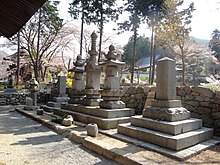Takeda Katsuyori
Takeda Katsuyori ( Japanese 武田 勝 頼 ; * 1546 ; † April 3, 1582 ) was a Japanese daimyo of the Sengoku period who took over the leadership of the Takeda clan after the death of his famous father and legendary general Takeda Shingen . However, he was not as tactically skilled as his father and led the Takeda to their worst defeat, which brought their important role in Japanese history to an abrupt end.
family
- Son: Takeda Nobukatsu .
- Father: Takeda Shingen
- Mother: Sanjō no kata
- Brothers:
- Takeda Yoshinobu , (1538-19 November 1567)
- Takeda Nobuchika , (1541–1582), (born blind, Seppuku during the invasion of Ieyasu and Oda in 1582; however, his son Takeda Nobumitsu was protected by Ieyasu).
- Takeda Harukiyo , (adopted, other name Nishina Morinobu, 157? -1582)
Historical role
He is one of the most tragic figures in Japanese history because, despite the outstanding importance of his clan in his youth, and despite all his efforts, he had to see the fall.
Katsuyori, born as Suwa Shirō ( 諏 訪 四郎 ), later Suwa Katsuyori, defeated his mother's Suwa clan and made Takatō Castle his seat of power. After his older brother Takeda Yoshinobu died, Katsuyori's son Nobukatsu became the leader of the Takeda clan, giving Katsuyori actual control. After the death of his father Shingen he took care of the family and fought with Tokugawa Ieyasu in the Takatenjin in 1574 and in the Nagashino in 1575. He took the Takatenjin Castle , which even his father had not been able to do before; which secured him the support of the Takeda clan, but he suffered a terrible defeat in Nagashino, due to one of the earliest recorded firing bursts by enemy infantry. Oda Nobunaga had around 3000 arquebuses and ordered his infantry to hide behind palisades and fire in rows one after the other. This enabled him to defeat the superior Takeda cavalry and kill a third of all 24 Takeda generals , an irretrievable loss for them. This was the decisive defeat for the rest of the three-pact of the East between the later Hōjō (clan) , and the Imagawa (clan) and the Takeda (clan) ( Imagawa Ujizane had already left). As a result, the three unions were able to annex or destroy the remaining sovereign principalities and usher in the Edo period .
literature
- Shibatsuji Shunroku and Hirayama Masaru: 武田 勝 頼 の す べ て ( Takeda Katsuyori no Subete ). Tokyo: Shin Jinbutsu Ōraisha, 2007.
- Shibatsuji Shunroku: Takeda Katsuyori . Tokyo: Shin Jinbutsu Ōraisha, 2003.
- Shibatsuji Shunroku: 甲 斐 武田 一族 ( The Kai Takeda Clan ), 2005, ISBN 4-40403-262-5
Web links
- Takeda Katsuyori no Saiki (Japanese)
- Yamanashi Prefecture page on Takeda Katsuyori (Japanese)
- http://wiki.samurai-archives.com/index.php?title=Takeda_Katsuyori (English)
- http://www.samurai-archives.com/katsuyori.html (English)
- http://hiroyasu.yinteing.com/tokugawa/battle-of-nagashino-and-the-decline-of-takeda-clan/ (English)
- http://folk.uio.no/arnsteio/samurai/takeda/TakedaKatsuyori.shtml (English, related to board game)
Individual evidence
- ↑ [1]
- ↑ 武田 勝 頼 . In: デ ジ タ ル 版 日本人 名 大 辞典 + Plus at kotobank.jp. Retrieved February 5, 2013 (Japanese).
| personal data | |
|---|---|
| SURNAME | Takeda, Katsuyori |
| ALTERNATIVE NAMES | 武田 勝 頼 (Japanese); Suwa Shirō (maiden name); 諏 訪 四郎 (maiden name, Japanese) |
| BRIEF DESCRIPTION | Japanese daimyo of the Sengoku period |
| DATE OF BIRTH | 1546 |
| DATE OF DEATH | April 3, 1582 |

